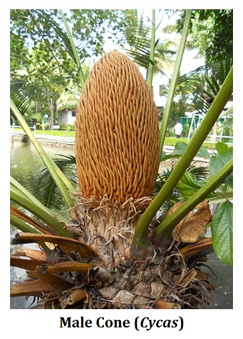Pteridophytes vs Gymnosperms
Pteridophytes
Pteridophytes are a group of primitive land plants belongs to Cryptogams. They are the first plant group with vascular tissue for the conduction of water and food materials and hence they are called as Vascular Cryptogams.
Gymnosperms
Gymnosperms are a group of primitive seed-producing plants of Spermatophytes (Phanerogams). They are ‘Naked-Seed’ Plants characterized by naked ovules (i.e., ovule without the ovary). The ovules of Gymnosperms are borne directly on the surface of the megasporophyl. Since ovary is absent, Gymnosperms do not produce fruits.
Pteridophytes occupy the intermediate position between Bryophytes and Gymnosperms (seed plants). Gymnosperms were believed to be originated from the Pteridophytes in the Devonian period (419 to 359 million years ago) of Paleozoic Era. Pteridophytes and Gymnosperms share many characteristics. In the previous posts, we discussed the General Characters of Bryophytes Pteridophytes and Gymnosperms. In this post, we will discuss the Similarities and Differences between Pteridophytes and Gymnosperms with Comparison Table.
Learn more: Bryophytes General Characteristics
Learn more: Pteridophytes General Characteristics
Learn more: Gymnosperms General Characteristics
Learn More: Geological Time Scale
Similarities between Pteridophytes and Gymnosperms
Ø Both Pteridophytes and Gymnosperms show alternation of generation with dominant sporophytic generation.
Ø In both groups, the sporophyte is differentiated into roots, stem and leaves.
Ø The leaves of some gymnosperms (Eg. Cycas) and ferns show circinate vernation (=young leaves coiled inward).

Circinate Vernation In Pteridophyte Leaves
Ø Dichotomous venation in ferns and in some Gymnosperms (Ginkgo).
Ø The xylem is devoid of vessels in both the groups.
Ø The phloem is devoid of companion cells.
Ø Secondary thickening present in fossil Pteridophytes and all Gymnosperms.
Ø The sporangia in both the groups are formed on specialized leaves called Sporophylls.
Ø All Gymnosperms and many Pteridophytes show heterospory.
Ø In some gymnosperms such as Cycas, and in some Pteridophytes the sporangia occur in groups called sorus.
Ø In heterosporous Pteridophytes and in all Gymnosperms, the gametophyte development is endosporic (inside the spore wall).
 Ø In Pteridophytes and in some Gymnosperms (Eg. Cycas, Ginkgo), male gametes are flagellated and motile.
Ø In Pteridophytes and in some Gymnosperms (Eg. Cycas, Ginkgo), male gametes are flagellated and motile.
Ø Megaspores are retained in the megasporangium in Gymnosperms and in some Pteridophytes.
Ø Archegonium is the female sex organ in both the groups.
Ø Development of distinct embryo after the fertilization in both groups.
Ø Embryo formation is endoscopic in many Pteridophytes and all Gymnosperms.
Ø Suspensor formation is present in some Pteridophytes and all Gymnosperms.
Ø Several primitive Gymnosperms such as members of Pteridospermales resemble Pteridophytes in their morphology, anatomy and reproduction.
Ø Cycadofilicales (fossil) were considered as ferns for a long time and are still called as ‘seed-ferns’.
A fossil specimen of Pteridospermale (a gymnosperm)
Difference between Pteridophytes and Gymnosperms
Sl. No. Pteridophytes Gymnosperms
1 Pteridophytes are mostly herbs or shrubs. Majority of Gymnosperms are trees.
2 Gametophyte and sporophyte are two separate plants (two independent plants) Gametophyte is completely dependent on sporophyte and they are physically connected.
3 Pteridophytes grow in mesophytic conditions. Majority of Gymnosperms grow in or show xerophytic conditions.
4 Stem is underground in most of the Pteridophytes. Stem is aerial in Gymnosperms.
5 Root system is adventitious type. Tap root system present.
6 Stele is not eustelic. All gymnosperms are eustelic.
7 Secondary growth usually absent. Secondary growth present.
8 Majority of Pteridophytes are homosporous, few are heterosporous. All Gymnosperms are heterosporous.
9 Ovules are not produced Ovules present
10 The megasporangium is without integument. The megasporangium of Gymnosperms (Ovule) is protected by integument.
11 No pollen tube formation. Pollen tube is formed.
12 Fertilization is not siphonogametic. Fertilization is siphonogametic.
13 Archegonia with neck canal cells. Archegonia without neck canals cells
14 Embryo formation is not elaborate, primitive embryo is produced. Embryo formation is elaborate and the embryo is comparatively advanced.
15 Seeds are not produced Typical seeds are produced
| You may also like... | ||
|---|---|---|
| NOTES | QUESTION BANK | COMPETITIVE EXAMS. |
| PPTs | UNIVERSITY EXAMS | DIFFERENCE BETWEEN.. |
| MCQs | PLUS ONE BIOLOGY | NEWS & JOBS |
| MOCK TESTS | PLUS TWO BIOLOGY | PRACTICAL |
You might also like…


these. lectures,notes,mcq’s must be in pdf form